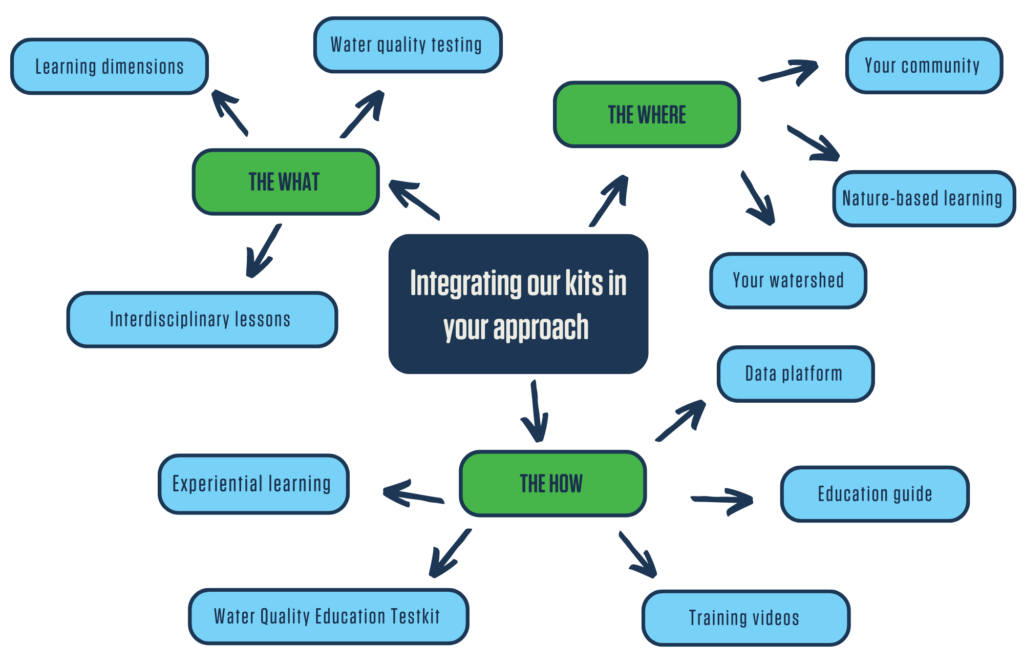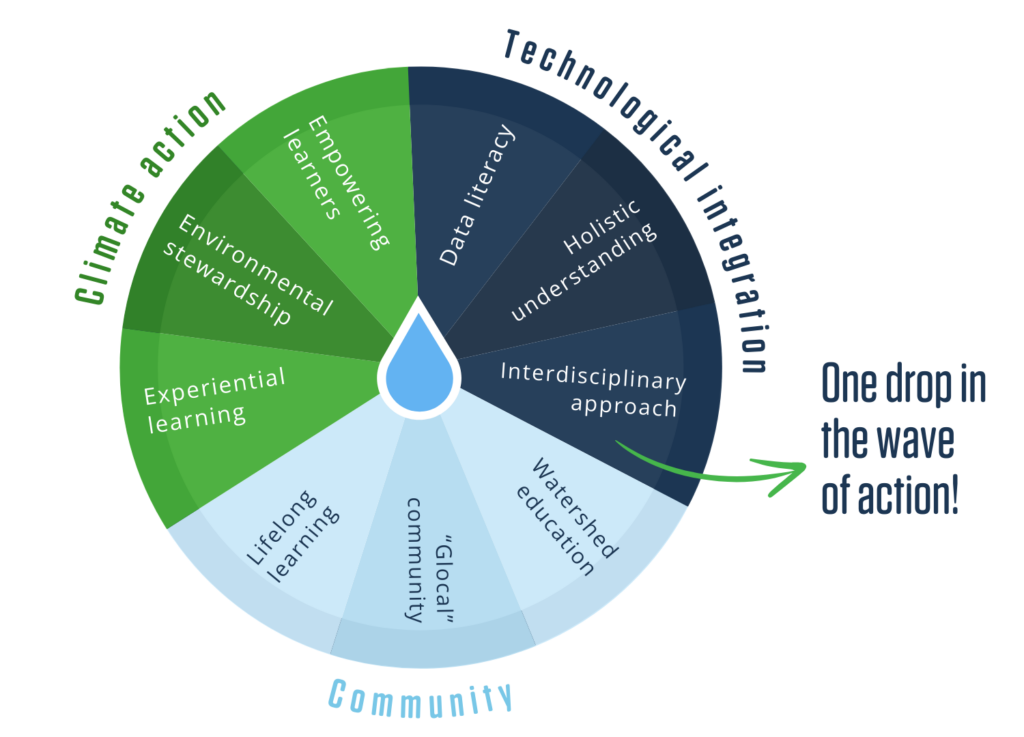Curriculum connections
We’re building the next generation of water leaders
At Water Rangers, we aim to empower educators with the resources and knowledge to bring water quality testing and environmental stewardship into their classrooms. Our educational framework is grounded on the belief that when people learn about, then test water, they are prompted to take action to protect it. Learn more about the ‘why’ behind our educational approach.
- Climate action: We believe in learning by doing, fostering students’ active participation while empowering them to take eco-action.
- Environmental stewardship: Engaging students in water quality testing to highlight the importance of protecting natural resources.
- Experiential learning: Providing hands-on activities that directly connect students with their local environment.
- Empowering learners: Equipping learners with the tools to demonstrate that society can respond effectively to climate challenges.
- Technological integration: Cultivating technological literacy using accessible tools and data-driven approaches, empowering learners to explore, analyze, and address environmental challenges.
- Data literacy: Using our data platform to teach students how to collect, analyze, and share water quality data.
- Holistic understanding: Encouraging Two-Eyed Seeing1 and Systems Thinking2 to embrace the interconnectedness and complexity of aquatic ecosystems.
- Interdisciplinary approach: Integrating science, math, social studies, and communication to develop critical thinking and 21st-century skills.
- Community: Fostering a connection with nature, community, and self, helping students develop a personal sense of ecological justice.
- Watershed education: Understanding that watersheds connect all surface water, emphasizing that homes, schools, and communities are integral parts of these ecosystems.
- “Glocal” Community: Recognizing that local watersheds drain into larger bodies of water and eventually the global ocean, ultimately connecting us all, and that local actions have global implications.
- Lifelong learning: Supporting learning across all settings – land, community, home, and school – blurring the lines between formal and informal education.
Current and emerging global trends in transformative education3 and Indigenous perspectives on learning4 shape our educational framework. In today’s rapidly changing world, we face growing challenges like climate change, globalization, environmental degradation, natural disasters, and further marginalization of vulnerable communities. These issues demand innovative approaches, as traditional methods struggle to address the complexities we now face. Additionally, the rising tide of eco-anxiety among young people (and everyone!) highlights the need for education that builds resilience and a sense of agency.
By engaging with our educational resources, you are shifting towards transformative learning and joining us in advancing Sustainable Development Goals (SDGs) 4 (Quality Education), 6 (Clean Water and Sanitation), 13 (Climate Action), and 14 (Life Below Water).
Together, we can nurture a generation of water leaders who are informed, proactive in their stewardship efforts, and empowered to act as agents of change in the green transition of our societies.
Our offerings
Educators play an important role in shaping the values, skills, and well-being of their students. We know that as an educator, YOU understand your students and curriculum best. Our goal is to make it straightforward for you to adapt our resources to meet your unique needs.
Water Rangers tools
- Comprehensive water test kits designed for educators, suitable for classroom and field use, complete with instructions and safety guidelines.
- An open-source data platform for recording and sharing water quality data, enabling collaboration within your school and community.
Educational resources
- In-class and field lessons that explore specific parameters while meeting learning objectives and competencies.
- Printables to replace the student handouts included in your kit, as well as extra resources like student and teacher equipment maps and data validation sheets.
Training and development
- Training sessions and workshops for educators to effectively use Water Rangers resources.
- Guest presentations for conferences, webinars, and professional development days.
- Extension opportunities, such as becoming a Blue School with the Canadian Ocean Literacy Coalition (COLC) and reserving their ‘Ocean, Freshwater and Us’ giant floor map to use with our kits.
Learning Dimensions
The learning objectives in each of our lesson plans cover one or more of three key dimensions:
- Knowledge and awareness
- Develop an understanding of water quality issues and the scientific processes involved in monitoring.
- Gain knowledge about local and global aquatic ecosystems.
- Eco-values, attitudes, and behaviours
- Foster a connection to nature and local water bodies.
- Address eco-anxiety by empowering students with actionable knowledge.
- Encourage proactive environmental stewardship.
- Core competencies
- Questioning and predicting: Formulating questions about water quality and predicting outcomes of experiments.
- Planning and conducting: Designing and conducting water quality tests.
- Processing and analyzing data and information: Collecting, recording, and interpreting water quality data.
- Evaluating: Assessing the validity and reliability of data and methods used.
- Applying and innovating: Using acquired knowledge to develop solutions for water-related issues.
- Communicating: Sharing findings with peers, the community, and through the Water Rangers data platform.
Integrating our kits to your approach
As an educator, you’re at the forefront of adapting to the ever-changing demands of local curricula. We deeply appreciate the work you do in navigating these shifts while inspiring your students.

Here are some tips on how to get started integrating our kits into your teaching:
Localize!
Watersheds are a great way to help students understand their place in the environment. Explore the water bodies near you and identify your watershed and ocean basin. When investigating your watershed with your class, look into the built and natural factors shaping the water bodies there. This may include:
Tip!
In all of our lessons, we connect to real-world and ocean-related topics. How can you make your own local connections to your water quality lessons?
- Different types of water bodies, like lakes, rivers, streams, and the ocean.
- Freshwater and saltwater ecosystems.
- The vegetation and wildlife in the area.
- Various forms of land use, such as urban, industrial, agricultural, residential, and natural.
- Human activities in the area, like recreation, industry, and habitat conservation.
Making learning relevant to students increases engagement and helps new ideas resonate.
Use our resources!
We have TONS of resources for educators because we want to make teaching about water quality as simple as possible! Besides our testkits, our resources are free to use and accessible online. Our lessons are a good starting point to gain insights on how to teach each of the parameters our kits test for. The learning objectives cover each of our learning dimensions, and all lessons are designed to build one or more of our core competencies.
You can also book a virtual training session with our staff, explore our parameters page, watch some of our many videos on how to use our kits, read our blog, and dive deeper into more ways to grow your water-ocean-climate education toolbox. We are proud to partner with leading outdoor and ocean education organizations like the Outdoor Learning Store and the Canadian Ocean Literacy Coalition, where you can explore more resources on water-ocean-climate education.
Are you located somewhere else?
Let us know! We’d love to connect with you to learn more about the work you’re doing and how we can support you. Contact our Education Coordinator here.
1 Albert Marshall, a respected Mi’kmaq elder, introduced the concept of Etuaptmumk, or Two-Eyed Seeing, which he describes as “learning to see from one eye with the strengths of Indigenous ways of knowing, and from the other eye with the strengths of Western ways of knowing, and using both of these eyes together” (Bartlett, Marshall, & Marshall, 2012, p. 335).
2 Systems thinking in environmental education helps us explore interconnected ecosystems, fostering critical thinking for sustainable solutions that support both community well-being and ecosystem health. Learn more and get free resources on systems thinking
3 United Nations Educational, Scientific, and Cultural Organization. (2024, June). Greening curriculum guidance: teaching and learning for climate action
4Assembly of First Nations (AFN). Plain Talk 9 – First Nations Holistic Lifelong Learning Model


